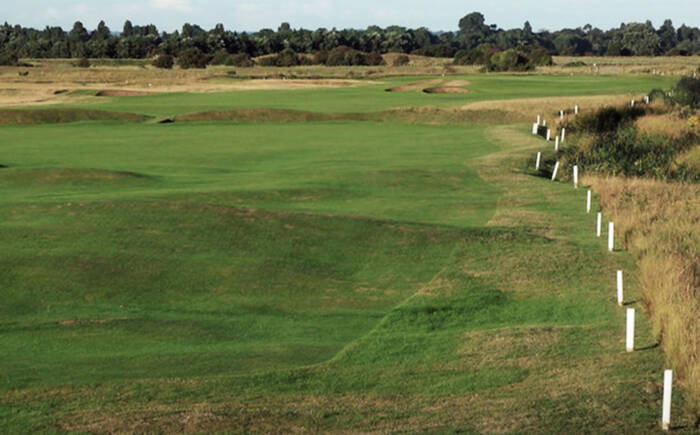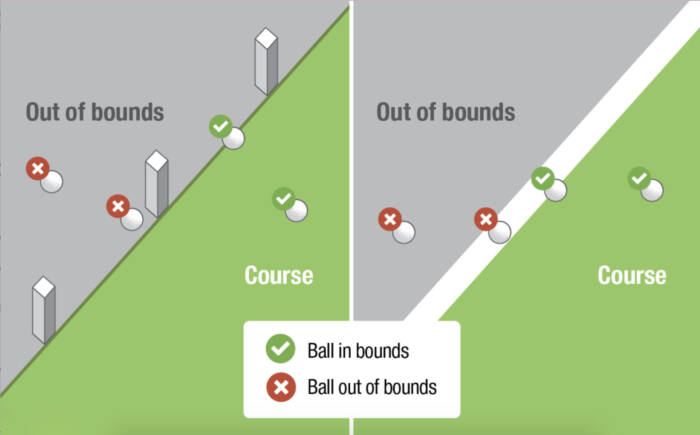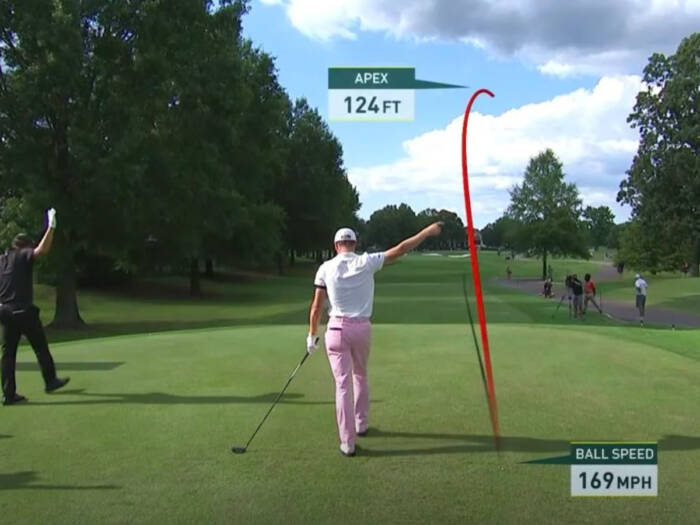Out of Bounds Golf Rule
Golf is governed by a comprehensive set of rules that ensure fairness and sportsmanship.
Among these rules, the concept of ‘Out of Bounds’ (sometimes referred to as OB or OOB) plays a crucial role.
It is essential for both casual golfers and professionals to understand the concept of ‘Out of Bounds’ and its implications on play
Even after 20+ years playing golf, I sometimes still question myself over my knowledge of some of the rules!
In this article, we’ll run through exactly what hitting it out of bounds means and what your options are when you (no doubt at some point) hit it OB!
What Does ‘Out of Bounds’ Mean in Golf?
‘Out of Bounds’ (OB) in golf refers to areas where play is prohibited. These areas are designated to maintain the integrity and challenge of the course.
Out of bounds areas are typically marked by white stakes or lines.
Understanding OB is vital because hitting a ball into an OB area results in specific penalties. These can significantly affect a player’s score and strategy on the course.
Identifying Out of Bounds Areas

Recognising Out of bounds areas on a golf course is crucial when planning your way around a golf course.
You can identify these areas through:
- Markers: White stakes or lines are commonly used to indicate OB boundaries
- Course Layout: Familiarising yourself with the course layout helps in identifying potential OB areas
- Fences or Walls: Sometimes used to mark the perimeter of the course
Understanding these indicators will help you make informed decisions on how to play your shots.
The Out of Bounds Rule in Detail

The Out of Bounds rule is integral to the Rules of golf and game’s structure and fairness.
A ball is considered Out of Bounds if it lies beyond the boundaries of the course as marked by designated stakes or lines. Similarly, a ‘lost ball’ is one that cannot be located within three minutes of beginning the search.
Once a ball is declared out of bounds, it cannot be played as it lies. However, when a ball crosses the OB boundary but returns onto the course, it is played as it lies without penalty.
In the section below, we’ll run through the steps you need to take if you hit your ball out of bounds or declare it lost.
Consequences of Hitting Out of Bounds

When a player’s ball is either lost or found out of bounds, the ‘stroke-and-distance’ procedure comes into play.
The rule requires the player to take a one-stroke penalty and play another ball from the location of the previous stroke.
Essentially, the player is penalised by both the stroke taken and the distance lost due to the errant shot, hence the name “stroke and distance”.
Hitting a ball Out of Bounds carries specific penalties that can impact a player’s score.
For example, if you hit your shot out of bounds from the tee, you count the tee shot you hit (1), plus a penalty stroke to replace a new ball from the tee (1). This means you are now playing your third shot from the tee.
This penalty can significantly increase the player’s score on a hole, affecting their overall standing in the game.
Exceptions to the Stroke-and-Distance Rule
While the stroke-and-distance rule is a fundamental aspect of golf, there are a few exceptions where different rules apply.
For example, if a ball is lost in a water hazard, the rules provide different options for dropping a new ball with a penalty, rather than returning to the original spot for a replay.
Similarly, if it is known or virtually certain that an outside influence (such as an animal) has moved the ball, the player is allowed to replace it without penalty.
The Optional Local Rule Alternative
In response to the often harsh consequences of the stroke-and-distance rule, the golfing authorities have introduced an optional Local Rule.
This rule provides an alternative to stroke-and-distance relief for a ball that is either lost outside a penalty area or is out of bounds. However it is generally recommended for casual play and not typically used in competitions.
Under this Local Rule, for two penalty strokes, a player can:
- Estimate the spot where the ball is lost or went out of bounds
- They find the nearest fairway edge that is not nearer the hole than the estimated spot
- The player can drop a ball in the fairway within two club-lengths of that fairway edge point or anywhere between there and the estimated spot where the ball is lost or went out of bounds.
This Local Rule aims to speed up play and reduce frustration for amateur golfers.
It allows for a more forgiving and faster resolution to a lost or out-of-bounds ball, without the need to return to the original spot for a replay.
It’s worth agreeing with your playing partners before a round or reviewing the local rules of the golf club before putting this rule into practice.
Playing a Provisional Ball
A crucial aspect of going out of bounds is the concept of the “provisional ball”.
This rule allows a player to play a second ball from the same spot as the original shot if there is a reasonable chance that the original ball is either lost outside a penalty area or out of bounds.
This is done to save time in case the original ball cannot be played (so you don’t have to walk back to the original place you played your last shot).
To play a provisional ball, the player must announce their intention to do so before making the stroke.
If the original ball is then found and is playable, the provisional ball is abandoned, and play continues with the original ball. However, if the original ball is lost or out of bounds, the provisional ball becomes the ball in play, with the player incurring a penalty stroke.
FAQs about the Out of Bounds Rule
Below we’ve answered some of the most common questions that we receive about the Out of bounds rule.
If your ball is not found within three minutes, it’s considered lost. You must play another ball from the location of the previous stroke, incurring a one-stroke penalty under the stroke-and-distance rule.
If an out of bounds fence, stake, or wall interferes with your stance or swing, you do not get free relief. You must either play the ball as it lies or declare it unplayable.
Out of bounds stakes are considered fixed and cannot be moved. If they interfere with your play, you must play around them or declare the ball unplayable.
If your ball is embedded in the ground and you cannot find it, the rules treat it as a lost ball. You would apply the stroke-and-distance rule, taking a penalty stroke and playing from the previous spot.